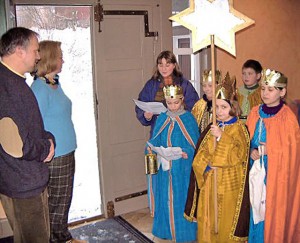Germans observe Three Kings Day, or Epiphany, Jan. 6. The day marks the end of the Christmas season. The Christmas tree is lit for the last time, discarded, and the ornaments are packed away until next Christmas. It’s one of Germany’s most traditional and characteristic religious holidays, but Jan. 6 is only a legal holiday in the states of Baden-Württemberg, Bavaria and Sachsen.

Children disguised as the three holy kings walk from door to door Dec. 27 to Jan. 6 asking for donations to support children’s projects.
After Christmas until late January, children disguise themselves as the three holy kings and can be seen walking from house to house in the KMC. They have paper crowns on their heads and carry a big golden star on a pole. They sing, pray and ask for charity collections for their parish. Usually, an adult member of their parish accompanies them.
Each year, about 500,000 children participate in the fundraiser event, which was established in 1959. In 2012, more than €43 million were collected to support projects and relief programs for children in Asia, Africa, Latin American, Oceania and Eastern Europe.
The children asking for donations represent Caspar, Melchior and Balthasar. In former times, when ringing doorbells, they received Christmas cookies, pretzels and sausages. After receiving a donation, the three holy kings would bless the house by writing “20C+M+B14” in chalk above the doors to keep evil from entering.
The three letters, C, M and B, don’t stand for the kings’ initials, but for the Latin words “Christus Mansionem Benedictat,” which literally means “Christ bless this home.”
The blessing has to stay over the door until the next Three Kings Day.


